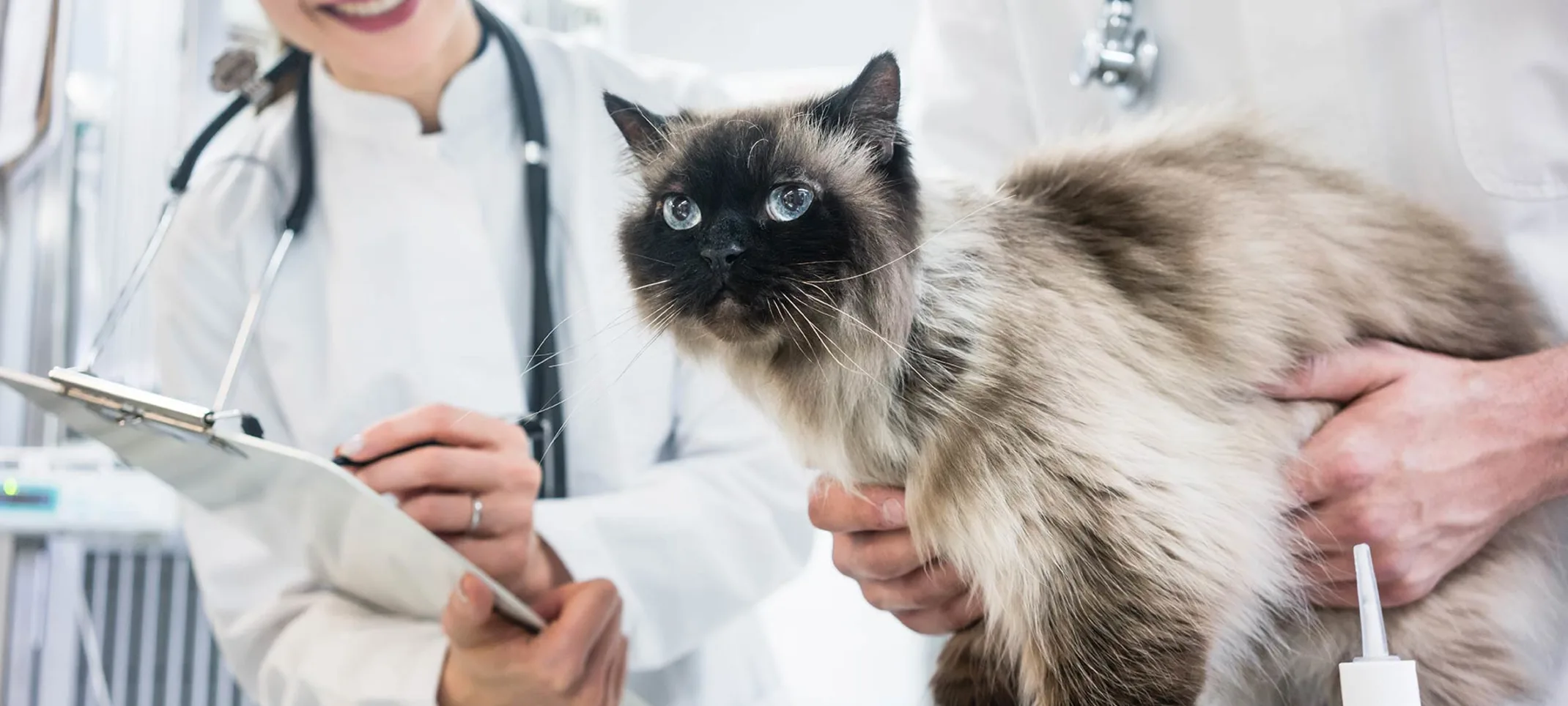Gilbertsville Veterinary Hospital
Parasite Prevention
Let’s get excited about your pet’s poop! No, really, it is important to understand why your veterinarian wants to perform a fecal analysis under a microscope each year. As a pet parent, learning about intestinal parasites and parasite control can protect you and your pet.

Some parasites are zoonotic, which means you (humans) can get it too. You can contract zoonotic disease by simply playing in a sandbox that was contaminated with feces containing roundworms. That is why the Veterinarians at Gilbertsville Veterinary Hospital made a list of common intestinal parasites, and labeled which ones are zoonotic.
Roundworms
Where are they located? Roundworms are found in the small intestines and can develop into large enough quantities that they cause intestinal blockage and possible death.
What do they look like? Adult Roundworms look like spaghetti and are visible with the naked eye. Roundworm eggs are only visible under a microscope. If your pet(s) has roundworms you may notice the adult roundworms in the patient’s stool or vomit.
How is it Transmitted? Roundworms are transmitted by the mother during pregnancy or through nursing. Roundworms are commonly diagnosed in puppies and kittens. Adult dogs and cats can become contaminated by consuming contaminated soil or ingesting an infected rodent.
Symptoms: Puppies that are diagnosed with roundworms may appear to have a pot-bellied look. All patients diagnosed with roundworms may vomit or have diarrhea containing adult roundworms.
Prevention/Treatment: Deworming medication will eliminate roundworms from your pet, and cleaning the environment of feces will help prevent reoccurance. Giving your dog a monthly dose of Simparica Trio and your cat a monthly dose of Revolution Plus is the best prevention.
Eliminating the Spread: To help eliminate the spread of roundworms to other pet(s) you should clean up after your pet defecates. Clean your pets backside after defecating with a wet paper towel. Practice proper hygiene by washing your hands with soap and water after playing with your pets. Clean your pets bedding frequently and avoid letting your pet lick your face.
Zoonotic: Yes! Roundworms can cause serious illness and blindness (Toxacara Migrans). People can be infected by ingesting contaminated soil located in sandboxes and beaches.
Tapeworms
Where are they located? Tapeworms are found in the small intestines. The adult tapeworm buries their head in the lining of the small intestines and is typically 6 – 12 inches long.
What do they look like? Tapeworms are long, flat and white in color, and when intact they can be relatively long. As they shed segments they appear to look like yellow/gold rice-like objects that can attach to the fur around your pet’s backside. You may also see these segments in your pet’s feces.
How is it Transmitted? The most common way your pet can become infected with a tapeworm is by ingesting a flea while grooming themselves. Tapeworms can also be spread through improperly prepared food.
Symptoms: Tapeworms rarely cause clinical signs, however, they do rob your pet of vital nutrients. Some clinical signs that you may notice are mild upset stomach and scooting.
Prevention/Treatment: Proper flea prevention should be used to help reduce the chances of your pet ingesting a flea. Avoid allowing your pet to hunt small rodents that may be infested with fleas. If your pet has tapeworms your veterinarian will recommend the proper deworming medication to treat your pet.
Zoonotic: Tapeworms are not zoonotic. However, humans can acquire tapeworms in the same fashion that your pets can.
Giardia
Where are they located? Giardia is a microscopic organism found in the small intestines.
What do they look like? Giardia is a single celled parasite only visible under a microscope.
How is it Transmitted? Pets become infected with Giardia by drinking water that is contaminated with the parasite. They may also ingest Giardia while grooming if they have come in contact with fecal material that was contaminated.
Symptoms: Symptoms include loose stools, diarrhea, vomiting and weight loss.
Prevention/Treatment: Medication if given to pets affected with Giardia. Some strains may be resistant to treatment and the patient may need more than one round of medication to clear the infection. Giving your pet fresh clean water and controlling the environment in which they live is the best way to prevent your pet from getting Giardia.
Zoonotic: The chances of humans getting infected with Giardia from their pet is extremely low.
Coccidia
Where are they located? Coccidia are single celled organisms that reproduce in intestinal cells leading to the death of the cell.
What do they look like? Coccidia can only be seen under the microscope and are not visible to the naked eye.
How is it Transmitted? Coccidia is commonly seen in puppies and kittens. Pets become infected with coccidia from other animals by ingesting infected dirt or feces.
Symptoms: Some clinical signs of coccidia are bloody or mucus-based, watery diarrhea. Coccidia can become serious if not properly treated causing death in immunocompromised pets.
Prevention/Treatment: Treatment involves dosing affected animals with medication (Albon, Ponazuril). Keeping infected animals apart is the best prevention.
Zoonotic: Coccidia is not considered zoonotic.
Whipworm
Where are they located? Whipworms live in the cecum and colon of the dog.
What do they look like? Whipworm adults are 2-3 inches in length. The eggs are microscopic and cannot be seen without a microscope. Also, adults do not shed eggs persistently, so multiple fecal analyses may be needed to confirm an infection.
How is it Transmitted? Whipworm eggs are passed in the feces, and under ideal conditions, they can cause whipworm infections after about two to four weeks in the environment. The eggs are ingested (for example, when a dog is grooming itself or eating things off the ground) and hatch in the small intestine. Eventually, the larvae move to the large intestine, taking about 11 weeks to become mature and capable of producing more eggs, which then pass to the environment. The eggs can survive for years in the environment. Whipworms are more common in older dogs than puppies, but they can infect dogs of any age.
Symptoms: In dogs with light infections, there are usually no symptoms. As an infection intensifies, inflammation of the large intestine can result, and any of the following symptoms may appear: Weight loss, Diarrhea, Mucus or blood in the stool, anemia (pale gums, weakness) can be seen with chronic, heavy infections.
Prevention/Treatment: Deworming medication is used to eliminate whipworm infections. However, some infections are resistant to medication and since the eggs can persist in the environment for years, multiple treatment cycles is common when treating whipworm infections.
Zoonotic: There have been rare and controversial reports of people being infected with canine whipworms. However, animal whipworms are not considered a significant human health risk.
HEARTWORM:
Unlike other parasites, heartworm is spread through mosquitoes. A mosquito will bite another dog (or fox, or coyote etc.), and when it feeds off a dog infected with heartworm, it will spread a microscopic version of a heartworm. Over 6 months, this worm will mature and travel to the right side of your dog’s heart. Untreated, this will cause inflammation, scarring and can lead to pulmonary hypertension and/or right-sided heart failure. Last year alone Gilbertsville Veterinary Hospital diagnosed more than 15 dogs with heartworm disease.
The best way to prevent heartworm disease is to keep your dog on heartworm preventative medication. There are many options available, including an oral chewable (Simparica Trio, Heartgard, Interceptor), a topical (Revolution), or an injection (Proheart). All of them work well, however the most important thing to remember is that mosquitoes can remain in your home during colder months. Therefore keeping your dog on Heartworm prevention year round is vital to prevent them from becoming ill if exposed.
“…if I keep my dog on heartworm prevention every month, why do I need to test them every year?”.
The answer is simple; if for any reason your dog doesn’t receive adequate protection every month (missed a dose by a week, vomits up the prevention, etc.), future doses of prevention do nothing to stop an adult worm from setting up house in the heart. If your dog develops an adult heartworm, prevention is not effective at removing it. Special injections of medication are required to remove the adult worm, and the longer it is present, the higher the risk of complications. Therefore, testing annually will help us potentially detect an adult worm before it leads to chronic changes in the heart and pulmonary artery.
FLEAS:
Fleas are a nuisance; they cause itching, skin problems, and can live in your home. However, they can also spread some diseases and are the main source of tapeworms. Unlike cockroaches, fleas cannot live in your home without a host. If you are seeing adult fleas on your pets, it is only a small fraction of the entire flea population. A single flea bath or spray will only work for 24 – 48 hours. At some point, more flea eggs will hatch, producing adults which will lay more eggs.
Therefore the solution to treating and preventing fleas is to use a monthly flea preventative. This will ensure that all young fleas that hatch cannot have a meal or reproduce, stopping their life cycle. For more information on flea infestation, click here.
There are many products available for fleas. We carry prescription medications for dogs (Simparica, Simparica Trio: oral chew, Revolution: Topical) and cats (Revolution Plus).
Unlike fleas, ticks rarely will live in your house. Most of the time cats or dogs will become exposed if they are outdoors. Short brush and high grass are the most common places for ticks to dwell. Unlike fleas, ticks can survive and attach even in the colder months. As we all know, ticks also carry common bacterial infections such as Lyme disease, Rocky Mountain Spotted Fever, Ehrlichia and anaplasmosis. Most of these diseases require the tick to be attached for several hours to spread these diseases. By using a monthly preventative the flea will die before it is able to infect your pet. Similar to fleas, we strongly recommend a prescription preventative (Dogs: Simparica, Simparica Trio, Cats: Revolution Plus) over any over the counter remedies.
